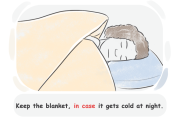Conjunctions of Condition
In this lesson, master conjunctions of condition to connect clauses showing conditions using combinations like "if," "unless," and "provided that." Clear explanations and practice exercises to help you learn.

What Are Conjunctions of Condition?
Conjunctions of condition are used to express a condition or contingency that must be met for something to happen or be true. They are words that connect two clauses or phrases to indicate that one is dependent on the other.
Common Conjunctions of Condition
The following list presents some of the conjunctions that can be used to form conditional sentences:
Here are a few examples using these conjunctions:
If they hold the party without me, I am going to get angry.
He was going to ditch us unless we told him the truth.
Once you learn it, you will love it for the rest of your life.
If
The conjunction 'if' is used to introduce a clause that expresses a condition or contingency that must be met for something to happen or be true. It is commonly used in the zero, first, second, third, and mixed conditionals. Here are a few examples:
If you were here, they wouldn't hurt me.
If Marco comes, I will stay for dinner.
Unless
Unless is used to indicate that something will not happen if something else does not happen. In other words, 'unless' means 'if not'. Here are a few examples:
He won't go to sleep unless you tell him a story.
Unless you call Alex, he won't leave the house.
Once
The conjunction 'once' usually means 'as soon as', but in some contexts, it can also mean the same as 'if'. In general, 'once' is used to indicate that something will happen immediately after a certain condition is met. For example:
Once you get to know him, he will seem really interesting.
Once he becomes angry, no one can control him.


Phrases That Indicate Conditions
There are some phrases that can act as conjunctions to link two clauses, where one of the clauses expresses a condition. Here are the phrases:
In case
As long as/so long as
Provided (that)
Only if
If only
In Case
'In case' is used to express the possibility that something might happen, and suggests provisions to prepare for that possibility by taking action or making a plan. It can also be used to express a condition or contingency that must be met in order for something to happen or be true. Here are a few examples:
We brought our blankets along, in case it gets cold at night.
In case he calls, tell him that his mother is ok now.
As Long As, So Long As
'As long as' and 'so long as' have the same meaning. They are both used to introduce a clause that expresses a requirement for something to happen. Check out the examples:
You can stay as long as you're quiet.
She would take care of the kids so long as you pay her.
Provided (that)
The conjunction 'provided' is sometimes followed by the word 'that'. Together, they are used to introduce a clause that expresses a condition, and can mean 'in a condition that', 'if', or 'only if'.
Check out a few examples:
You can stay here, provided that your mother is ok with it.
The doctor will help, provided that he is not pretending to be sick.
Only If
Only if is a more emphatic form of 'if' used to introduce an exclusive condition that is the only way something will be possible. Here are a few examples:
Maria will talk to him, only if it benefits her.
Only if you read more about history, you can understand that it repeats over and over.
If Only
If only is used to express a hypothetical or wishful condition in which something unpleasant could be avoided or changed. Check out these examples for more clarification:
If only she had paid more money, we could have been sure that the products are original.
I would do whatever I could if only she asked me.
Review
Conjunctions of condition are used to express a particular condition for something else to happen. They can be single words or phrases that can link two clauses. Here are the English conditional conjunctions.
If
Unless
Once
In case
As long as/so long as
Provided (that)
Only if
If only
Quiz:
Which sentence correctly uses a conjunction of condition?
She sings well, although she never practices.
I'll lend you my notes, if you need them.
He runs every day, since he wants to get fit.
We waited for hours, because the train was late.
Which sentence uses "as long as" correctly to express a condition?
She'll join the hike as long as the weather is stormy.
He can eat dessert as long as he finishes his vegetables.
They canceled the trip as long as the car broke down.
I'll call you as long as I never see you again.
Sort the words to form a correct sentence.
Which sentence expresses a hypothetical or wishful condition using a conjunction?
If he finishes early, he'll join us for dinner.
If only I had studied harder, I could have passed the exam.
As long as it's sunny, we'll eat outside.
In case it rains, we'll stay home.
Complete each sentence using the correct conjunction of contract.
You can borrow my laptop
you return it by 5 PM.
you have your passport, you won't be allowed on the international flight.
you submit the report by noon, we can review it today.
Take an umbrella
it rains later.
She will sign the contract
the terms include flexible working hours.
Comments
(0)